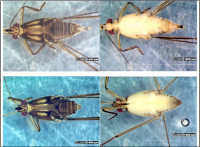Unique Marine Insects (Hemiptera) From North Sulawesi and Self-Defense Mechanism Against Sun Exposure http://www.doi.org/10.26538/tjnpr/v6i12.15
Main Article Content
Abstract
Marine insects are constantly exposed to ultraviolet radiation. How the marine insect Hemiptera: Gerridae responds to UV stress and the molecular mechanisms underlying this adaptation are still unknown. This study analyzed the adaptability of marine insects that are constantly exposed to UV radiation by extracting anti-UV compounds produced by these marine insects. These marine insects have the ability to produce anti-UV B compounds and anti UV A compound with a high point of absorbance, because it is able to absorb UV-B (280 nm- 320 nm) with the highest absorbance value at point 4 with a wavelength of 280 nm - 300 nm, and is also capable to absorb
UV-A (320 nm – 400 nm) with the highest absorbance value at point 3.5 with a wavelength of 340 nm.
Downloads
Article Details

This work is licensed under a Creative Commons Attribution-NonCommercial-NoDerivatives 4.0 International License.
References
Dunlap WC and Shick JM. Review-ultraviolet radiation-absorbing MYCOSPORINE-like amino acids in coral reef organisms: A biochemical and environmental perspective. J Phycol. 1998; 34:418–30.
Sun Y, Zhang N, Zhou J, Dong S, Zhang X, Guo L, Guo G. Distribution, contents, and types of mycosporine-like amino acids (Maas) in marine macroalgae and a database for Maas based on these characteristics. Marine Drugs 2020; 18:43.
Klisch M. Mycosporine-like amino acids and marine toxins - the common and the different. Marine Drugs 2008; 6:147–63.
Andersen N and Cheng L. The marine insecthalobates(heteroptera: Gerridae). Oceanography and Marine Biology. 2004; 119–179.
Dias JF and Lopes CL. Occurrence, distribution and abundance of Halobates Micans Eschscholtz, 1822 (Heteroptera, Gerridae) along the southeastern Brazilian coast. Brazilian J Biol. 2009; 69:67–73.
Moreira FF, Alecrim PV, Ribeiro JR, Nessimian JL. Identification key to the Gerridae (Insecta: Heteroptera: Gerromorpha) from the Amazon River floodplain, Brazil, with new records for the Brazilian Amazon. Zoologia (Curitiba) 2011; 28:269–79.
Suh S-S, Hwang J, Park M, Seo H, Kim H-S, Lee J, Moh SH, Lee T-K. Anti-inflammation activities of mycosporine-like amino acids (Maas) in response to UV radiation suggest potential antiskin aging activity. Marine Drugs 2014; 12:5174–87.
Libkind D, Sommaruga R, Zagarese H, van Broock M. Mycosporines in carotenogenic yeasts. Syst and Appl Microbiol. 2005; 28:749–54.
Kittle PD. The biology of water striders (Hemiptera: Gerridae) in Northwest Arkansas. American Midland Naturalist 1977; 97:400.
Carreto JI, Carignan MO, Montoya NG. Comparative studies on mycosporine-like amino acids, paralytic shellfish toxins and pigment profiles of the toxic dinoflagellates alexandrium tamarense, A. Catenella and A. Minutum. Marine Ecology Progress Series. 2001; 223:49–60.
Andersen NM and Weir TA. The sea skaters, genus halobates eschscholtz (Hemiptera: Gerridae), of Australia: Taxonomy, Phylogeny and zoogeography. Invertebrate Systematics 1994; 8:861.
Cheng L, Yang CM, Andersen NM. Guide to the Aquatic Heteroptera of Singapore and Peninsular Malaysia. I. Gerridae and Hermatobatidae. The
Raffles Bulletin of Zoology. 2001; 49(1):129–148.
Buzzetti FM, Nieser N, Damgaard J. Notes on water bugs drom South East Asia and Australia (Heteroptera: Nepomorpha & Gerromorpha). Atti Acc Rov Agiati, a 256, 2006; 6(8):31-45.
Polhemus JT and Polhemus DA. Three new species of marine water-striders from the Australasian region, with notes on other species (Gerridae: Halobatinae, Trepobatinae). Raffles Bul Zool. 1991; 39(1):1-13.
Chen PP and Nieser N. Gerridae, mainly from Sulawesi and Pulau Buton (Indonesia). Notes on Malesian aquatic and semiaquatic bugs (Heteroptera), III. Tijdschrift voor Entomologie. 1992; 135:145-62.
Lansbury I. Notes on the marine-freshwater gerrid genus Rheumatobates (Hemiptera, Gerridae) of Papua New Guinea. Tijdschrift Voor Entomologie.1992; 135:1-10.
Zettel H. Limnoptera spinosa, new species (Heteroptera: Gerridae), a rare water strider from Indonesia and Malaysia. The Raffles Bul Zool. 2002; 50(1):137-141.
Cheng L, Spear L, Ainley DG. Importance of Marine Insects (Heteroptera: Gerridae, Halobates spp.) as Prey of Eastern Tropical Pacific Seabirds. Marine Ornithology.2010; 38(2):91- 5.
Semiun CG, Lengur ER, Boli Duhan GU. Insect diversity profile of Mangrove ecosystem in Menipo Nature Tourism Park, East Amarasi, East Nusa tenggara. IOP Conference Series: Materials Science and Engineering 2020; 823:012050.
Heckman CW. Encyclopedia of south american aquatic insects: Hemiptera - heteroptera: Illustrated keys to known families, genera, and species in South America. Scholars Portal. 2011; 679.
Miyamoto KT, Komatsu M, Ikeda H. Discovery of gene cluster for mycosporine-like amino acid biosynthesis from actinomycetales microorganisms and production of a novel mycosporine-like amino acid by heterologous expression. Appl Env Microbiol. 2014; 80:5028–36.
Cheng L. A bug on the ocean waves (Heteroptera, Gerridae, Halobates Eschscholtz). Neue series 50. 2006; 1033-40.
Kusumawati HA, Farhamzah FY, Alkandahri1 M, Sadino AS, Agustina LD, Apriana S. Antioxidant Activity and Sun Protection Factor of Black Glutinous Rice (Oryza sativa var. glutinosa): 2021 Nov. 1 [cited 2022];5(11):1958-61. Available from: https://www.tjnpr.org/index.php/home/article/view/316
Laksmiani NPL, Leliqia NPE, Armita PMN, Arijana NIGK, Saputra AABY, Prananingtyas KI. In-silico and In-vitro Studies of Antioxidant and Sun Protection Activities of Sappan Wood (Caesalpinia sappan L.): TJNPR [Internet]. 2020 Dec. 1 [cited 2022];4(12). Available from: https://www.tjnpr.org/index.php /home/article/view/860
Verawati V, Almahdy A, Febriyenti F, Putra DP. In vitro and in vivo evaluation of photoprotective effect of Elephantopus Mollis extracts: 2022; 6(3):365-70.
Conde FR, Carignan MO, Churio MS, Carreto JI. In vitro cistrans photoisomerization of palythene and usujirene. Implications on the in vivo transformation of mycosporine-like amino acids. Photochemistry and photobiology.2003:77(2);146–50.


